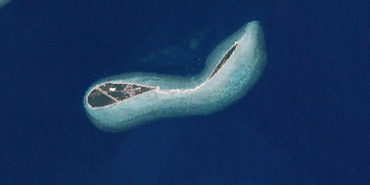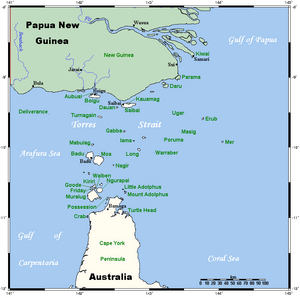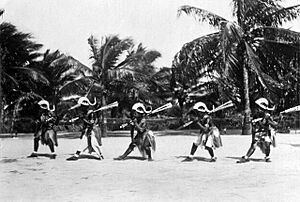Masig Island, Queensland facts for kids
Quick facts for kids Masig IslandQueensland |
|||||||||||||||
|---|---|---|---|---|---|---|---|---|---|---|---|---|---|---|---|

Masig Island (left) and Kodall Island (right)
|
|||||||||||||||
| Population | 283 (2021 census) | ||||||||||||||
| • Density | 189/km2 (490/sq mi) | ||||||||||||||
| Area | 1.5 km2 (0.6 sq mi) | ||||||||||||||
| Time zone | AEST (UTC+10:00) | ||||||||||||||
| LGA(s) | Torres Strait Island Region | ||||||||||||||
| State electorate(s) | Cook | ||||||||||||||
| Federal Division(s) | Leichhardt | ||||||||||||||
|
|||||||||||||||
Masig Island, also known as Yorke Island, is a small island and community in the Torres Strait Island Region of Queensland, Australia. In 2021, about 283 people lived there.
The name Masig comes from the Kalau Lagau Ya language. It describes this coral cay island, which is part of the Torres Strait Islands group. Masig is located in the eastern part of the central Torres Strait, near the top of the Great Barrier Reef. It lies northeast of Cape York Peninsula in Queensland.
The Masigalgal people are the traditional owners of Masig. They are part of the Kulkulgal nation from the Central Torres Strait. These people have Melanesian roots. For thousands of years, they lived by hunting, fishing, farming, and trading. This was their way of life long before Europeans arrived.
The Queensland Government moved people from Aureed Island to Masig after it became a special reserve. Masig families used to own lugger boats for the pearling and shell industry. When this industry ended in the 1960s, they switched to commercial fishing. They became very good at catching mackerel, prawns, and crayfish. Since the late 1970s, a successful fish factory on the island has frozen their catch. This seafood is then flown to markets in southern Australia.
Masig Island is one of the Yorke Islands. The other island in this group is Kodall Island.
Contents
Island Location and Features
Masig/Yorke Island is located northeast of Coconut/Poruma Island. It lies southwest of Stephens/Ugar Island and Darnley/Erub Island. It is also northwest of Murray/Mer Island. The island is about 160 kilometers (100 miles) northeast of Thursday Island.
Masig is a very small, flat coral island. It is about 2.7 kilometers (1.7 miles) long and 0.8 kilometers (0.5 miles) wide. The land is mostly flat, usually less than 3 meters (10 feet) above sea level. Over half of the island is covered with natural plants and dense trees.
Masig Island is close to several important sea passages:
- Moon Passage to the north-west
- Great North East Channel to the north-west
- Cumberland Passage to the south-east
- Hibernia Passage to the south-east
The Bourke Isles are located south of Masig Island.
A Look Back: Masig Island's History
The Masigalgal people, from the Kulkulgal nation, are the traditional owners of Masig. They have lived there for thousands of years.
The Torres Strait Islander people of Masig are of Melanesian origin. They were skilled navigators and knew the reefs very well. They played a central role in the trading networks of the Torres Strait.
In September 1792, Captain William Bligh visited the Torres Strait. He was in charge of the British Navy ships Providence and Assistant. Bligh mapped the main reefs and channels in the area.
Early Industries and European Contact
In the 1860s, boats started coming to the Torres Strait to collect sea cucumbers and pearls. William Banner set up a sea cucumber station in 1863. He hired Islander men from Masig to work on his boats as divers and crew.
By the 1870s, Masig was attracting many different people. Some came because of the pearl and trochus shell industry. Teachers from the London Missionary Society also arrived around this time.
In 1872, the Queensland Government wanted to control more of the islands. The British Government agreed, creating a new boundary for Queensland. This boundary included all islands within 60 nautical miles of the coast. In 1879, the boundary was extended even further. This allowed the Queensland Government to manage the sea cucumber and pearling businesses.
An American whaler named Edward (Ned) Mosby, also known as "Yankee Ned," arrived in 1871. He later started a sea cucumber business on Yorke Island in the late 1870s. He leased half the island from the Queensland Government for his business.
In 1882, Captain Charles Pennefather visited Masig. Mosby and his partner complained that another boat crew was cutting down Wongai fruit trees for fuel. Steamships often stopped at Masig to get firewood, which led to trees being cut down on the island.
The Coming of the Light and Community Changes
Torres Strait Islanders call the arrival of London Missionary Society (LMS) missionaries in July 1871 "the Coming of the Light." The first LMS missionaries visited Masig in 1872. Around 1900, a missionary named Reverend Walker started a business called Papuan Industries Limited. This company helped Islander communities buy their own pearl luggers, called "company boats." These boats were used to collect pearl shells and sea cucumbers, which the company then sold.
The people of Masig bought their first company boats around 1905. These boats gave Islanders income and a sense of community pride. They also improved travel and communication between the islands. Ned Mosby's son, "Yankee," also operated pearl luggers from Masig.
In November 1912, the Queensland Government officially set aside 320 acres of land on Masig as an Aboriginal reserve. Many other Torres Strait Islands became reserves at the same time. The government then moved people from Aureed Island to Masig.
A government school opened on Masig in 1912. By 1918, a Protector of Aboriginals was appointed to Thursday Island. In the 1920s and 1930s, strict laws were applied to Torres Strait Islanders. These laws allowed the government to move Islanders to reserves and missions across Queensland.
Challenges and Resistance
In 1920, a worldwide influenza epidemic reached the Torres Strait. It caused 96 deaths in the region. The Queensland Government sent food to Masig, Iama, and Poruma to help them recover. In March 1923, a strong hurricane hit Masig and Poruma. It destroyed local crops and gardens. After this, the Queensland Government built new facilities on Masig in the 1930s. These included a store, a court house, and better roads.
In 1936, about 70% of the Torres Strait Islander workforce went on strike. This was the first organized protest by Torres Strait Islanders against government control. The strike lasted nine months. Islanders were angry about the government controlling their jobs and money. They protested against rules about wages, trade, and curfews. They also wanted to choose their own boat crews and travel freely between islands.
This strike led to important changes. The unpopular local Aboriginal Protector was replaced. A new system of regular meetings with elected Islander council representatives was set up. The new island councils were given some power, including control over local police and courts.
On August 23, 1937, the first Inter Islander Councillors Conference was held at Masig. Representatives from 14 Torres Strait communities attended. Barney Mosby, Dan Mosby, and William represented Masig. They discussed many issues, and unpopular rules like evening curfews were removed. A new way for local people to be represented was agreed upon.
In 1939, the Queensland Government passed the Torres Strait Islander Act 1939. This law included many of the ideas from the conference. A key part of the new act officially recognized Torres Strait Islanders as a separate people from Aboriginal Australians.
World War II and Beyond
During World War II, the Australian Government asked Torres Strait Islander men to join the armed forces. Men from Masig and other islands formed the Torres Strait Light Infantry Battalion. Even though they were respected soldiers, they only received one-third of the pay given to white Australian servicemen. On December 31, 1943, members of the Torres Strait Light Infantry went on strike. They demanded equal pay and equal rights. The Australian Government agreed to increase their pay to two-thirds of what white servicemen received. In the 1980s, the Australian Government offered full back pay to these servicemen.
After World War II, the pearling industry in the Torres Strait declined. Islanders were then allowed to work and live on the Australian mainland. In the 1970s, prawn and fishing businesses started on Masig. Masig families continued to operate their lugger boats until the pearl industry collapsed in the 1960s. After that, they successfully moved into commercial mackerel, prawning, and crayfish fishing.
In 1970, the Australian Government started a turtle farm on the island. This was meant to provide jobs for Torres Strait Islander people. However, turtles take a long time to grow, and it cost more to farm them than they were worth. The project was later stopped, and the remaining turtles were released into the sea.
In December 1978, Australia and Papua New Guinea signed a treaty. This treaty set the boundaries between the two countries. It also explained how both countries could use the sea area. The Torres Strait Treaty started in February 1985. It allows people to move freely between both countries without passports or visas. This free movement is for traditional activities like fishing, trading, and family gatherings. These activities happen in a special Protected Zone.
Yorke Island State School opened on January 29, 1985. On January 1, 2007, it became the Yorke Island Campus of Tagai State College.
On March 30, 1985, the Masig community elected three councillors. They formed an independent Masig Island Council. This council was given local government powers and duties. The council area, which was once a reserve held by the Queensland Government, was transferred to the council's care on October 21, 1985.
Native title was recognized over Masig in 2000. This means the Masigalgal (Torres Strait Islander) Corporation holds the traditional rights to the land.
In 2007, a government group suggested that the 15 Torres Strait Island councils should be replaced. They recommended creating the Torres Strait Island Regional Council. The first Torres Strait Island Regional Council was elected on March 15, 2008.
Population and Demographics
In 2016, Masig Island had a population of 270 people. In 2021, Masig Island had a population of 283 people.
Education on Masig Island
Yorke Island Campus (Masig Muysaw Ngurpay Lag) is a primary school. It teaches children from Early Childhood to Year 6. It is part of Tagai State College, which has its main office on Thursday Island. The school is located at 131 William Street.
There is no secondary school on Masig Island. The closest secondary school is Tagai State College on Thursday Island, which is about 150 kilometers (93 miles) away. For older students, options include distance education (learning from home) or attending boarding schools.
Community Facilities
The Yorke Island SES Facility is on Barneys Road. This is where emergency services are based.
The Masig (Yorke Island) Primary Health Care Centre is at 115 Aous Road. A qualified nurse works at the health center. There is also a doctor who provides medical services to Masig and three other nearby islands: Coconut, Yam, and Warraber.
The island also has an IBIS store and a Mini-Mart for shopping.
Travel and Transport
Yorke Island Airfield is 1 kilometer (0.6 miles) long. It runs across the island from north to south.
A regular flight service is operated by West Wing Aviation from Horn Island. Otherwise, you can reach Masig by charter plane or boat. All goods and mail are delivered by a weekly barge service and by the scheduled air service.
Masig Island in Popular Culture
Yorke Island was used as a filming location for the Australian television series, RAN Remote Area Nurse.





